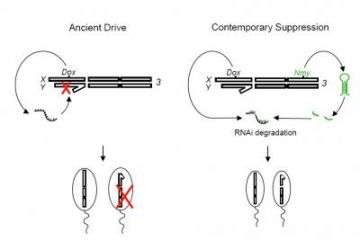A sex-ratio meiotic drive system in Drosophila simulans

If you met a person who had 10 children, all of whom were girls, you would probably find this surprising. Yet this kind of distorted sex ratio does occur in groups as diverse as mammals, insects, and plants, where some parents consistently produce litters in which the sex ratio is dramatically skewed. For the first time, Yun Tao and colleagues report, in this week’s issue of the open-access journal PLoS Biology, the identification of both a fly gene that can create these skewed ratios and the counter-gene, found in most of the fly population, which suppresses such distortion.
Skewed sex ratios, such as the one investigated by Tao and colleagues at Harvard and Emory Universities, have been known to evolutionary biologists for a long time. They usually occur because genes on the X chromosome “prefer” an individual to have female offspring, as daughters will have two copies of X chromosome genes compared to one in sons, and more copies of a gene mean evolutionary success for that gene.
This sets up a conflict within the genome, as genes on the other chromosomes may lose out through being passed on to an all female litter. When there is a skew towards one sex, being a gene in a member of the other sex is very advantageous, as the rare sex will have lots of opportunities to reproduce. This makes finding a gene on the non-sex chromosomes that counters the distortion evolutionarily likely.
The mystery of the sex ratio skew was in how it worked on a molecular and genetic level. This paper is the first to map a distorting gene, Dox, found on the X chromosome in Drosophila simulans, and Nmy, the suppressor gene found on a non-sex chromosome that “fights back” for an equal sex ratio. Interestingly, the new paper reports that Dox and Nmy are very similar in terms of their sequence. This provides Tao et al. with a clue towards how Nmy may defeat Dox—a mechanism called RNA interference (RNAi).
RNAi can “turn off” a gene—just like Nmy does to Dox—when one gene produces RNA that is complementary in sequence to that of another. On a physiological level, Tao et al. showed that males who have offspring with a distorted sex ratio do so because their Y-bearing sperm fail to mature successfully. The findings in this paper also suggest that the evolution of the genome will one day be explained as adaptations to limit sex ratio distortion.
Citation: Tao Y, Masly JP, Araripe L, Ke Y, Hartl DL (2007) A sex-ratio meiotic drive system in Drosophila simulans. I: An autosomal suppressor. PLoS Biol 5(11): e292. doi:10.1371/journal.pbio.0050292
Citation: Tao Y, Araripe L, Kingan SB, Ke Y, Xiao H, et al. (2007) A sex-ratio meiotic drive system in Drosophila simulans. II: An X-linked distorter. PLoS Biol 5(11): e293. doi:10.1371/journal.pbio.0050293
Source: Public Library of Science, www.plosbiology.org


















